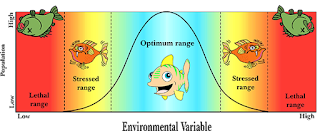Condition and Resources
Distribution of
the invasive freshwater shrimp Palaemon
sinensis (Sollaud, 1911) in rivers of Hiroshima Prefecture, western Japan
Hidetoshi Saito, Aiko Yamasaki,
Junpei Watanabe and Koichiro Kawai, Graduate School of Biosphere Science,
Hiroshima University, 1-4-4 Kagamiyama, Higashi-Hiroshima 739-8528, Japan Faculty
of Applied Biological Science, Hiroshima University, 1-4-4 Kagamiyama,
Higashi-Hiroshima 739-8528, Japan

Gambar 1. Palaemon sinensis
The freshwater palaemonid
shrimp, Palaemon sinensis was
imported into Japan from China as live fishing bait, In that study, field
research was conducted to confirm the distribution of this invasive shrimp in
eight rivers in Hiroshima Prefecture, western Japan. A longitudinal
distribution analysis showed that P.
sinensis occurred in the lower reaches, whereas P. paucidens showed a wider distribution from the upper to the
lower reaches. Palaemon sinensis
occurred in a narrow range of stream velocity (0–2 cm/s) compared with that of P. paucidens (0–18 cm/s). P. sinensis density was negatively
correlated with river velocity, indicating that this shrimp prefers a lentic
water environment. Palaemonetes sinensis (see
Ashelby et al. 2012; De Grave and Ashelby 2013), are supplied under the trade
name “Shirasa ebi” in western Japan as live fishing bait for rockfish. They
examined and identified both species based on the difference in carapace colour
pattern (Imai and Oonuki 2014). Water quality data at the sampling sites where P. sinensis was found, were 0 for
salinity, 6.63–10.03 mg/l for DO, 6.0–12.5 ms/m for electrical conductivity,
and 0–2 cm/S for velocity Water quality data
at the sampling sites where P. Paucidens was found were 0–1.5 for salinity, 6.48–9.27 mg/l for Do, 4.0–224.1 ms/m
for electrical conductivity, and 0–18 cm/S for velocity. In the last three
rivers, it was found in lower reaches at 3–9 m of altitude and 2.0–4.8 km from
the river mouth. Their
results show that P. sinensis has a narrow
range of stream velocity (0–2 cm/s) compared with that of P. paucidens (0–18 cm/s). Stepwise
multiple regression revealed that the density of P.sinensis was negatively correlated
with water velocity. P. sinensis reportedly occurs in lentic downstream environments of Far East Russia
(Kawai and Nakata 2011). Caridean shrimp species that
inhabit lotic environments are classified into two types based on their methods
of adaptation, i.e., amphidromous shrimp species that metamorphose in a marine
environment and lay smaller eggs,
and landlocked shrimp that lead their entire life history
in a river and lay fewer large eggs (Shokita 1979). C.leucosticta and M. nipponense were collected in the tidally influenced areas and/or
adjacent freshwater area. These shrimp are considered to be diadromous and
migrate between the river and sea to spawn (Armada et al. 1993; Kawai and
Nakata 2011; Saito et al. 2012; Toyota and Seki 2014). In fresh water areas, landlocked shrimp,
such as P. sinensis, P. paucidensand Neocaridina spp.
were distributed and lay fewer large eggs (Shokita 1979; Shih and Cai 2007; Oonuki
et al. 2010; Toyota and Seki 2014). These shrimp are important components of
aquatic ecosystems, playing a key role at intermediate tropic levels, as
consumers of algae, detritus and small insects, and as prey of many fishes
(Kawai and Nakata 2011; Puspitasari 2013).
Resources : Water
Condition : Water
quality of river (salinity, DO, electricity conductivity, velocity)
Performance: methods of adaptation, i.e.,
amphidromous shrimp species that metamorphose in a marine environment and lay
smaller eggs, and landlocked shrimp that lead their entire life history in a river and lay fewer large eggs
REFERENCES
Kawai T, Nakata N (2011) Shrimps, Crabs
and Crayfishes: Conservation and Biology of Freshwater Crustaceans. Seibutsukenkyusha,
Tokyo, 460 pp (in Japanese)
Oonuki T, Suzuki N, Akiyama N (2010)
Annual reproductive cycle of the female Palaemonetes sinensisrecorded for the
first time in a pond of Hamamatsu City, Shizuoka Prefecture, Japan. Aquaculture
Science 58: 509–516 (in Japanese with English abstract)
Shih HT, Cai Y
(2007) Two new species of the land-locked freshwater shrimps genus, NeocaridinaKubo,
1938 (Decapoda: Caridea: Atyidae), from Taiwan, with notes on speciation on the
island. Zoological Studies46: 680–694
Shokita S (1979) The distribution and speciation
of the inland water shrimps and prawns from the Ryukyu Islands-II. Bulletin of
the College of Science, University of the Ryukyus28: 193–287 (in Japanese with
English abstract)
Toyota K, Seki S (2014) Shrimp & Crab.
Seibundo-Shinkosha, Tokyo, 255 pp (in Japanese)




saya masih kurang pagam dengan grafik yang anda sajikan
BalasHapusmohon dijelaskan sedikit